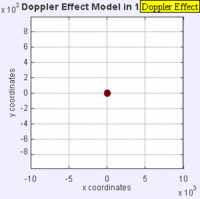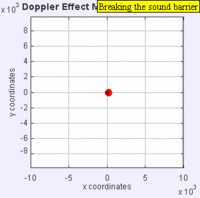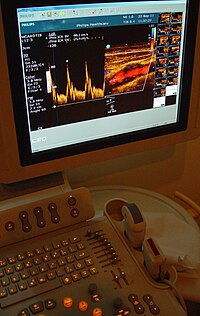Doppler effect
The Doppler effect (or Doppler shift) is the change in frequency of a wave (or other periodic event) for an observer moving relative to its source. It is named after the Austrian physicist Christian Doppler, who proposed it in 1842 in Prague. It is commonly heard when a vehicle sounding a siren or horn approaches, passes, and recedes from an observer. Compared to the emitted frequency, the received frequency is higher during the approach, identical at the instant of passing by, and lower during the recession.
When the source of the waves is moving toward the observer, each successive wave crest is emitted from a position closer to the observer than the previous wave. Therefore, each wave takes slightly less time to reach the observer than the previous wave. Hence, the time between the arrival of successive wave crests at the observer is reduced, causing an increase in the frequency. While they are travelling, the distance between successive wave fronts is reduced, so the waves "bunch together". Conversely, if the source of waves is moving away from the observer, each wave is emitted from a position farther from the observer than the previous wave, so the arrival time between successive waves is increased, reducing the frequency. The distance between successive wave fronts is then increased, so the waves "spread out".
For waves that propagate in a medium, such as sound waves, the velocity of the observer and of the source are relative to the medium in which the waves are transmitted. The total Doppler effect may therefore result from motion of the source, motion of the observer, or motion of the medium. Each of these effects is analyzed separately. For waves which do not require a medium, such as light or gravity in general relativity, only the relative difference in velocity between the observer and the source needs to be considered.
Contents
[hide]Development[edit]
Doppler first proposed this effect in 1842 in his treatise "Über das farbige Licht der Doppelsterne und einiger anderer Gestirne des Himmels" (On the coloured light of the binary stars and some other stars of the heavens).[1] The hypothesis was tested for sound waves by Buys Ballot in 1845.[2] He confirmed that the sound's pitch was higher than the emitted frequency when the sound source approached him, and lower than the emitted frequency when the sound source receded from him. Hippolyte Fizeau discovered independently the same phenomenon on electromagnetic waves in 1848 (in France, the effect is sometimes called "effet Doppler-Fizeau" but that name was not adopted by the rest of the world as Fizeau's discovery was six years after Doppler's proposal).[3] In Britain, John Scott Russell made an experimental study of the Doppler effect (1848).[4]
General[edit]
In classical physics, where the speeds of source and the receiver relative to the medium are lower than the velocity of waves in the medium, the relationship between observed frequency  and emitted frequency
and emitted frequency  is given by:[5]
is given by:[5]
 and emitted frequency
and emitted frequency  is given by:[5]
is given by:[5]-
- where
 is the velocity of waves in the medium;
is the velocity of waves in the medium; is the velocity of the receiver relative to the medium; positive if the receiver is moving towards the source (and negative in the other direction);
is the velocity of the receiver relative to the medium; positive if the receiver is moving towards the source (and negative in the other direction); is the velocity of the source relative to the medium; positive if the source is moving away from the receiver (and negative in the other direction).
is the velocity of the source relative to the medium; positive if the source is moving away from the receiver (and negative in the other direction).
The frequency is decreased if either is moving away from the other.
The above formula assumes that the source is either directly approaching or receding from the observer. If the source approaches the observer at an angle (but still with a constant velocity), the observed frequency that is first heard is higher than the object's emitted frequency. Thereafter, there is a monotonic decrease in the observed frequency as it gets closer to the observer, through equality when it is coming from a direction perpendicular to the relative motion (and was emitted at the point of closest approach; but when the wave is received, the source and observer will no longer be at their closest), and a continued monotonic decrease as it recedes from the observer. When the observer is very close to the path of the object, the transition from high to low frequency is very abrupt. When the observer is far from the path of the object, the transition from high to low frequency is gradual.
If the speeds  and
and  are small compared to the speed of the wave, the relationship between observed frequency
are small compared to the speed of the wave, the relationship between observed frequency  and emitted frequency
and emitted frequency  is approximately[5]
is approximately[5]
 and
and  are small compared to the speed of the wave, the relationship between observed frequency
are small compared to the speed of the wave, the relationship between observed frequency  and emitted frequency
and emitted frequency  is approximately[5]
is approximately[5]| Observed frequency | Change in frequency |
|---|---|
 |  |
- where

 is the velocity of the receiver relative to the source: it is positive when the source and the receiver are moving towards each other.
is the velocity of the receiver relative to the source: it is positive when the source and the receiver are moving towards each other.
Analysis[edit]
The frequency of the sounds that the source emits does not actually change. To understand what happens, consider the following analogy. Someone throws one ball every second in a man's direction. Assume that balls travel with constant velocity. If the thrower is stationary, the man will receive one ball every second. However, if the thrower is moving towards the man, he will receive balls more frequently because the balls will be less spaced out. The inverse is true if the thrower is moving away from the man. So it is actually the wavelength which is affected; as a consequence, the received frequency is also affected. It may also be said that the velocity of the wave remains constant whereas wavelength changes; hence frequency also changes. Note that in the ball analogy, the speed of the balls is dependent on the speeds of the thrower and receiver which is not the case of the wavefront velocity which remains constant.
With an observer stationary relative to the medium, if a moving source is emitting waves with an actual frequency  (in this case, the wavelength is changed, the transmission velocity of the wave keeps constant
(in this case, the wavelength is changed, the transmission velocity of the wave keeps constant  note that the transmission velocity of the wave does not depend on the velocity of the source), then the observer detects waves with a frequency
note that the transmission velocity of the wave does not depend on the velocity of the source), then the observer detects waves with a frequency  given by
given by
 (in this case, the wavelength is changed, the transmission velocity of the wave keeps constant
(in this case, the wavelength is changed, the transmission velocity of the wave keeps constant  note that the transmission velocity of the wave does not depend on the velocity of the source), then the observer detects waves with a frequency
note that the transmission velocity of the wave does not depend on the velocity of the source), then the observer detects waves with a frequency  given by
given by
A similar analysis for a moving observer and a stationary source (in this case, the wavelength keeps constant, but due to the motion, the rate at which the observer receives waves  and hence the transmission velocity of the wave [with respect to the observer]
and hence the transmission velocity of the wave [with respect to the observer]  is changed) yields the observed frequency:
is changed) yields the observed frequency:
 and hence the transmission velocity of the wave [with respect to the observer]
and hence the transmission velocity of the wave [with respect to the observer]  is changed) yields the observed frequency:
is changed) yields the observed frequency:
These can be generalized into the equation that was presented in the previous section.
An interesting effect was predicted by Lord Rayleigh in his classic book on sound: if the source is moving at twice the speed of sound, a musical piece emitted by that source would be heard in correct time and tune, but backwards.[6]
Application[edit]
Sirens[edit]
The siren on a passing emergency vehicle will start out higher than its stationary pitch, slide down as it passes, and continue lower than its stationary pitch as it recedes from the observer. Astronomer John Dobson explained the effect thus:
- "The reason the siren slides is because it doesn't hit you."
In other words, if the siren approached the observer directly, the pitch would remain constant until the vehicle hit him, and then immediately jump to a new lower pitch. Because the vehicle passes by the observer, the radial velocity does not remain constant, but instead varies as a function of the angle between his line of sight and the siren's velocity:
where  is the angle between the object's forward velocity and the line of sight from the object to the observer.
is the angle between the object's forward velocity and the line of sight from the object to the observer.
 is the angle between the object's forward velocity and the line of sight from the object to the observer.
is the angle between the object's forward velocity and the line of sight from the object to the observer.Astronomy[edit]
The Doppler effect for electromagnetic waves such as light is of great use in astronomy and results in either a so-called redshift or blueshift. It has been used to measure the speed at which stars and galaxies are approaching or receding from us, that is, the radial velocity. This is used to detect if an apparently single star is, in reality, a close binary and even to measure the rotational speed of stars and galaxies.
The use of the Doppler effect for light in astronomy depends on our knowledge that the spectra of stars are not homogeneous. They exhibitabsorption lines at well defined frequencies that are correlated with the energies required to excite electrons in various elements from one level to another. The Doppler effect is recognizable in the fact that the absorption lines are not always at the frequencies that are obtained from the spectrum of a stationary light source. Since blue light has a higher frequency than red light, the spectral lines of an approaching astronomical light source exhibit a blueshift and those of a receding astronomical light source exhibit a redshift.
Among the nearby stars, the largest radial velocities with respect to the Sun are +308 km/s (BD-15°4041, also known as LHS 52, 81.7 light-years away) and -260 km/s (Woolley 9722, also known as Wolf 1106 and LHS 64, 78.2 light-years away). Positive radial velocity means the star is receding from the Sun, negative that it is approaching.
Radar[edit]
Main article: Doppler radar
The Doppler effect is used in some types of radar, to measure the velocity of detected objects. A radar beam is fired at a moving target — e.g. a motor car, as police use radar to detect speeding motorists — as it approaches or recedes from the radar source. Each successive radar wave has to travel farther to reach the car, before being reflected and re-detected near the source. As each wave has to move farther, the gap between each wave increases, increasing the wavelength. In some situations, the radar beam is fired at the moving car as it approaches, in which case each successive wave travels a lesser distance, decreasing the wavelength. In either situation, calculations from the Doppler effect accurately determine the car's velocity taking into account wind speed and direction relative to the car. Moreover, theproximity fuze, developed during World War II, relies upon Doppler radar to detonate explosives at the correct time, height, distance, etc.[citation needed]
Medical imaging and blood flow measurement[edit]
An echocardiogram can, within certain limits, produce an accurate assessment of the direction of blood flow and the velocity of blood and cardiac tissue at any arbitrary point using the Doppler effect. One of the limitations is that the ultrasound beam should be as parallel to the blood flow as possible. Velocity measurements allow assessment of cardiac valve areas and function, any abnormal communications between the left and right side of the heart, any leaking of blood through the valves (valvular regurgitation), and calculation of the cardiac output. Contrast-enhanced ultrasound using gas-filled microbubble contrast media can be used to improve velocity or other flow-related medical measurements.
Although "Doppler" has become synonymous with "velocity measurement" in medical imaging, in many cases it is not the frequency shift (Doppler shift) of the received signal that is measured, but the phase shift (when the received signal arrives).
Velocity measurements of blood flow are also used in other fields of medical ultrasonography, such as obstetric ultrasonography andneurology. Velocity measurement of blood flow in arteries and veins based on Doppler effect is an effective tool for diagnosis of vascular problems like stenosis.[7]
Flow measurement[edit]
Instruments such as the laser Doppler velocimeter (LDV), and acoustic Doppler velocimeter (ADV) have been developed to measurevelocities in a fluid flow. The LDV emits a light beam and the ADV emits an ultrasonic acoustic burst, and measure the Doppler shift in wavelengths of reflections from particles moving with the flow. The actual flow is computed as a function of the water velocity and phase. This technique allows non-intrusive flow measurements, at high precision and high frequency.
Velocity profile measurement[edit]
Developed originally for velocity measurements in medical applications (blood flow), Ultrasonic Doppler Velocimetry (UDV) can measure in real time complete velocity profile in almost any liquids containing particles in suspension such as dust, gas bubbles, emulsions. Flows can be pulsating, oscillating, laminar or turbulent, stationary or transient. This technique is fully non-invasive.
Satellite communication[edit]
Fast moving satellites can have a Doppler shift of dozens of kilohertz relative to a ground station. The speed, thus magnitude of Doppler effect, changes due to earth curvature. Dynamic Doppler compensation, where the frequency of a signal is changed multiple times during transmission, is used so the satellite receives a constant frequency signal.[8]
Audio[edit]
The Leslie speaker, associated with and predominantly used with the Hammond B-3 organ, takes advantage of the Doppler Effect by using an electric motor to rotate an acoustic horn around a loudspeaker, sending its sound in a circle. This results at the listener's ear in rapidly fluctuating frequencies of a keyboard note.
Vibration measurement[edit]
A laser Doppler vibrometer (LDV) is a non-contact method for measuring vibration. The laser beam from the LDV is directed at the surface of interest, and the vibration amplitude and frequency are extracted from the Doppler shift of the laser beam frequency due to the motion of the surface.
 |
|
| Problems playing this file? See media help. | |
Inverse Doppler effect[edit]
Since 1968 Scientists such as Victor Veselago have speculated about the possibility of an Inverse Doppler effect. An experiment that claimed to have detected this effect was conducted by Nigel Seddon and Trevor Bearpark in Bristol, United Kingdom in 2003.[9]
Researchers from Swinburne University of Technology and the University of Shanghai for Science and Technology showed that this effect can be observed in optical frequencies as well. This was made possible by growing a photonic crystal and projecting a laser beam into the crystal. This made the crystal act like a super prism and the Inverse Doppler Effect could be observed.














No comments:
Post a Comment